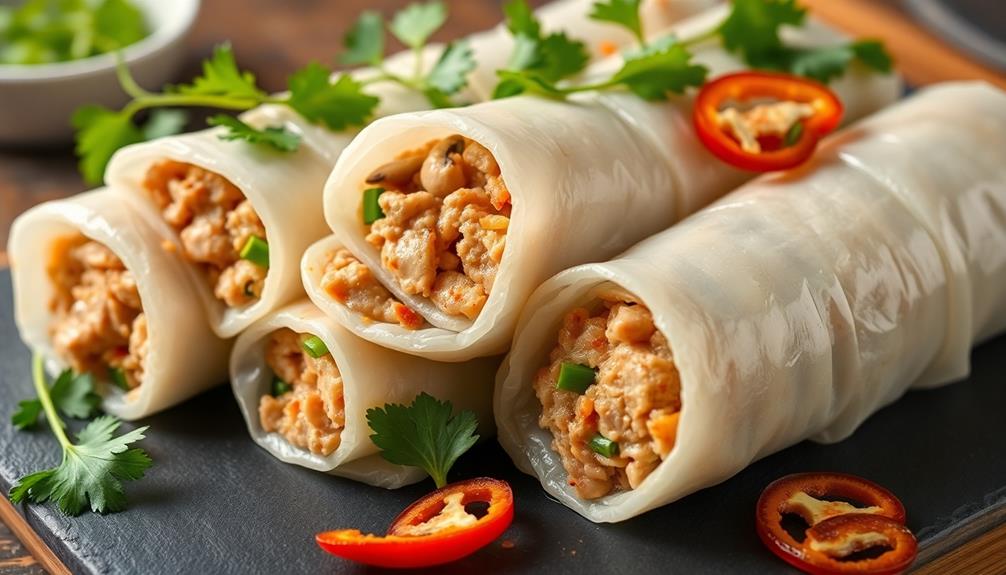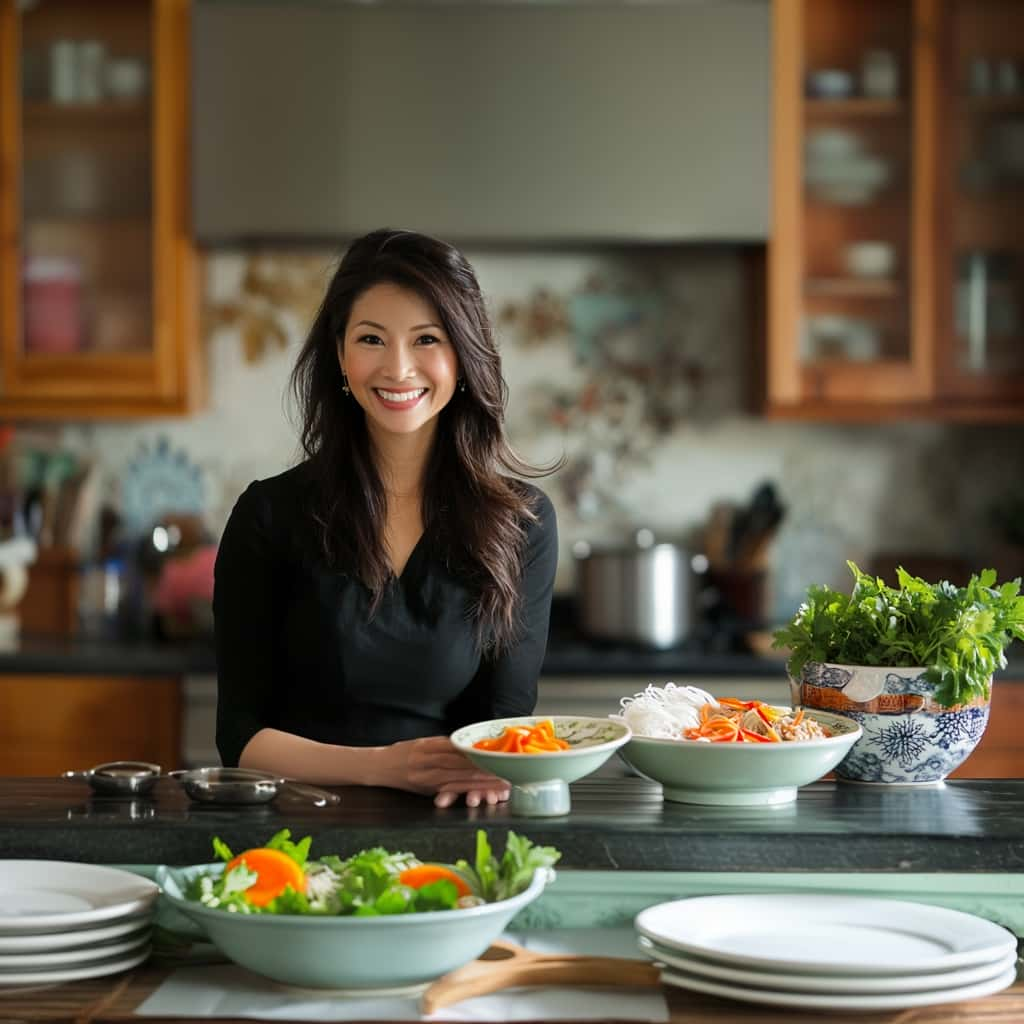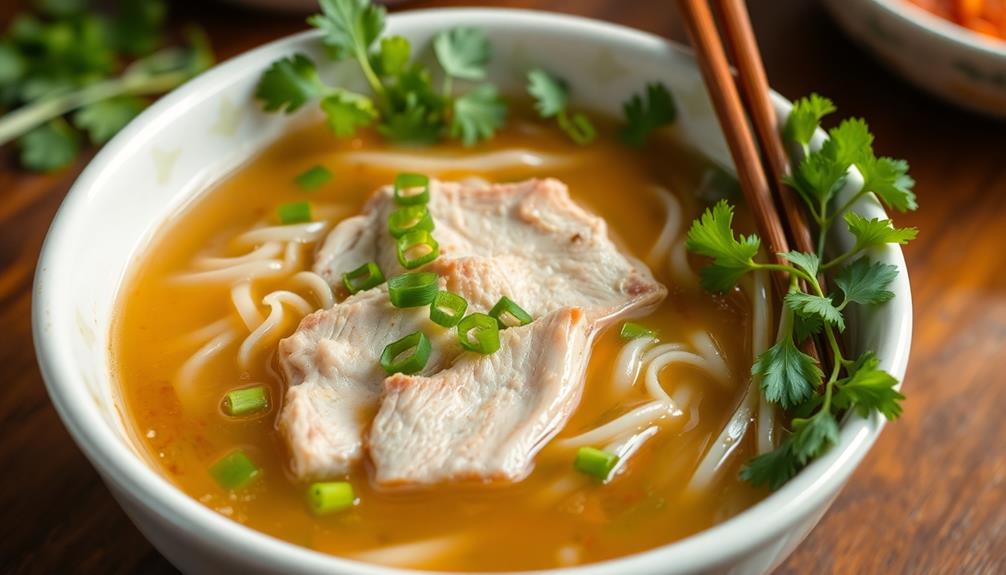Let's dive into the mouthwatering world of banh cuon! These soft, silky steamed rice rolls have a rich history that's as delicious as the dish itself. Originating in northern Vietnam, banh cuon are made by pouring a thin batter onto a cloth-covered steamer, then skillfully rolling the cooked sheets around a savory filling of seasoned pork and mushrooms. Top them with fresh herbs, crispy fried shallots, and a tangy dipping sauce for a heavenly flavor explosion. Banh cuon are not just a tasty treat – they're a cherished part of Vietnamese culture, often enjoyed during special gatherings. Keep reading to uncover more about this captivating culinary gem. Banh cuon are not only delicious, but they are also a nutritious option. The use of steamed rice and fresh herbs makes them a fresh and healthy choice. In many Vietnamese households, making banh cuon is a family affair, with each member contributing to the preparation process. Another popular dish that shares similar traits with banh cuon is the fresh and healthy spring rolls, known for their light and refreshing taste.
Key Takeaways
- Banh Cuon is a beloved Vietnamese dish with roots tracing back to the 19th century, representing the country's rich culinary heritage.
- The dish is traditionally served during special occasions and family gatherings, symbolizing hospitality and generosity.
- Banh Cuon features a soft, silky rice wrapper that encloses a savory filling, often including ground pork, mushrooms, and fresh herbs.
- Preparing Banh Cuon requires specialized techniques, such as steaming the batter on cloth over boiling water to achieve the desired texture.
- Banh Cuon is often enjoyed with a variety of dipping sauces, creating a harmonious balance of flavors and enhancing the overall dining experience.
History
Originating in northern Vietnam, banh cuon's history can be traced back centuries. This delightful rice roll dish has been a beloved part of Vietnamese cuisine for generations, passed down through families and celebrated in communities.
You can almost smell the fragrant aromas of the steamed rice batter and savory fillings as you imagine the skilled hands of Vietnamese cooks carefully assembling these delicate rolls. The process of making banh cuon is an art form, requiring patience and precision to achieve the perfect texture and flavor.
Over time, different regions have put their own spin on the recipe, but the core elements – the thin, supple rice sheets and the flavorful fillings – have remained the same.
Whether you're enjoying a traditional version or trying a modern twist, every bite of banh cuon is a delicious connection to Vietnam's rich culinary heritage.
Recipe
Banh Cuon, a beloved Vietnamese dish, is a delicate and savory steamed rice roll that showcases the country's vibrant culinary heritage. The thin, delicate sheets of rice batter are steamed to perfection, then filled with a flavorful mixture of ground pork, mushrooms, and aromatic herbs. The result is a delightful balance of textures and flavors that tantalizes the taste buds.
The process of making Banh Cuon may seem intricate, but with a bit of practice, it becomes a rewarding and satisfying culinary experience. The key to success lies in the proper preparation of the rice batter and the careful assembly of the rolls.
Ingredients:
- Rice flour
- Water
- Pork, ground
- Woodear mushrooms, thinly sliced
- Shallots, minced
- Garlic, minced
- Fish sauce
- Sugar
- Salt
- Pepper
- Cilantro, chopped
- Mint leaves
Cooking Instructions:
In a large bowl, combine the rice flour and water, whisking until a smooth, pourable batter is formed. Cover and let the batter rest for at least 30 minutes.
In a skillet, sauté the ground pork, woodear mushrooms, shallots, and garlic until the pork is cooked through and the vegetables are tender. Season the mixture with fish sauce, sugar, salt, and pepper.
To assemble the Banh Cuon, lightly grease a steamer basket and heat it over a pot of simmering water. Scoop a small amount of the batter onto the steamer and use a spatula to spread it into a thin, round sheet. Steam the sheet for about 1 minute, or until it's translucent and pliable.
Transfer the steamed sheet to a plate and spoon a portion of the pork and mushroom filling onto one side. Fold the sheet over the filling and serve immediately, garnished with fresh cilantro and mint leaves.
When making Banh Cuon, be mindful of the delicate rice batter and handle the steamed sheets with care to avoid tearing. Experiment with different fillings and toppings to create your own unique variations on this traditional Vietnamese delight.
Cooking Steps
Now it's time to get cooking! First, you'll blend together the batter ingredients.
Then, you'll carefully pour the batter onto the steamer and gently peel away the delicious steamed rice rolls.
Finally, add your favorite filling and serve the rolls with a tasty dipping sauce.
Get ready to enjoy the amazing flavors of homemade banh cuon!
Step 1. Make Batter by Blending
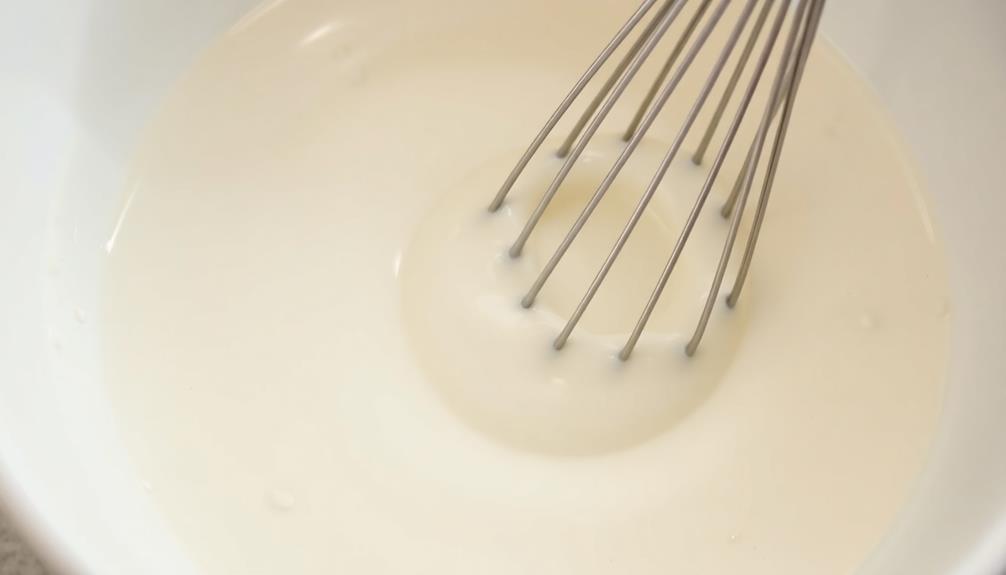
To make the batter, you'll want to blend the rice flour, tapioca starch, salt, and water until you have a smooth, pourable consistency.
Don't be afraid to really give it a good whirl in the blender! You want the batter to be nice and silky, with no lumps or bumps.
Once it's all blended up, you can give it a quick taste to check the seasoning. If it needs a touch more salt, just add a little bit and blend again.
Now that your batter is ready, you're one step closer to making those delicious steamed rice rolls!
The next step is to steam the batter in batches to create the soft, thin sheets.
Get ready to witness the magic as the batter transforms into those irresistible banh cuon.
With a little patience and practice, you'll be rolling up these Vietnamese delights like a pro.
Just wait until you get to enjoy that first bite – it's going to be so worth it!
Step 2. Pour Batter Onto Steamer

Once your batter is ready, you'll want to begin pouring it onto the oiled steamer surface. Dip your ladle into the smooth, runny batter and gently pour it in a circular motion, creating a thin, even layer across the steamer.
Listen as the batter sizzles and bubbles, filling the air with the delightful aroma of rice and steam.
Keep a close eye on the rolls as they cook, patiently waiting for the edges to turn a delicate, translucent shade. When the center is no longer sticky and the rolls have a delicate, pliable texture, it's time to remove them from the steamer.
Use your chopsticks to carefully peel the rolls off the surface, taking care not to tear them.
Repeat this process, pouring and steaming the batter until you've created a stack of perfectly cooked, silky-smooth banh cuon.
Get ready to enjoy the fruits of your labor – these steamed rice rolls are sure to delight your taste buds!
Step 3. Gently Peel Steamed Rice Roll

Gently peeling the steamed rice rolls off the surface requires careful attention.
You'll want to use your fingers to carefully lift the delicate dough from the steamer, taking care not to tear it. Move slowly and deliberately, using a light touch to avoid any mishaps.
As you peel, you'll notice the soft, supple texture of the rice roll – it should feel silky smooth to the touch. Gently unfurl the roll, unveiling the filling inside. The aroma of savory meats and aromatic herbs will start to waft up, making your mouth water in anticipation.
Once fully unrolled, you can admire the lovely layers and delicate pleats. Be sure to transfer the roll to a plate without any creases or folds.
Repeat this process for each steamed rice roll, working with care and precision. With a little practice, you'll be peeling and plating these beauties like a pro in no time!
Step 4. Add Filling
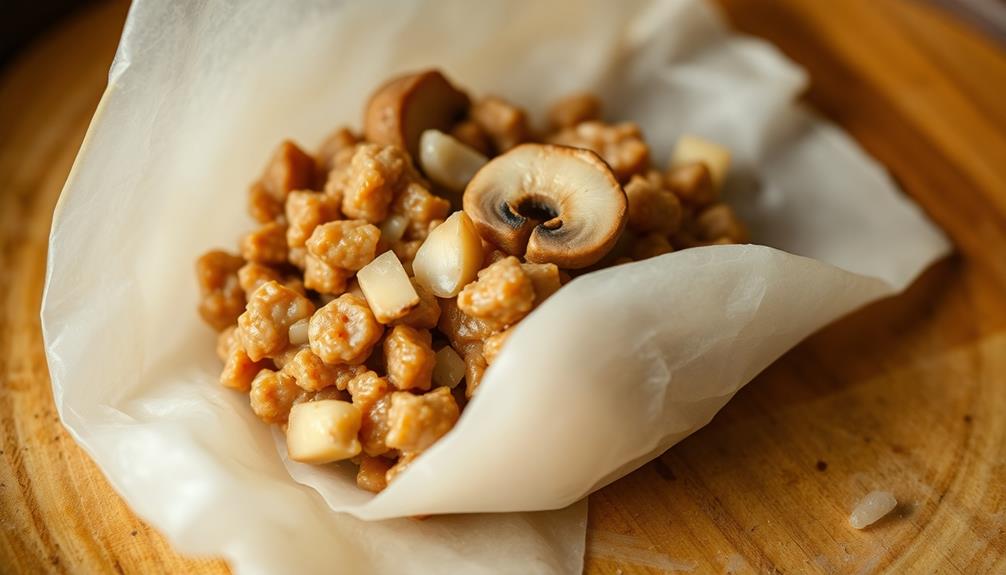
After peeling the steamed rice rolls, you'll add the filling.
First, prepare the savory ground pork mixture by sautéing it in a pan with some oil until it's nicely browned. Mmm, can you smell that delicious aroma?
Next, you'll add some minced onions, garlic, and a pinch of salt and pepper. Sauté everything together until the onions are soft and translucent.
Now, it's time to spoon a bit of the pork filling into the center of each steamed rice roll. Gently fold the sides over the filling, creating a neat little package. Don't worry if it's not perfect – the beauty is in the homemade touch!
Finally, arrange your filled banh cuon on a serving platter. You can garnish them with crispy fried shallots, fresh herbs, and a drizzle of flavorful dipping sauce.
Get ready to dig in and enjoy the irresistible combination of soft, chewy rice rolls and savory pork filling!
Step 5. Serve Rolls With Dipping Sauce
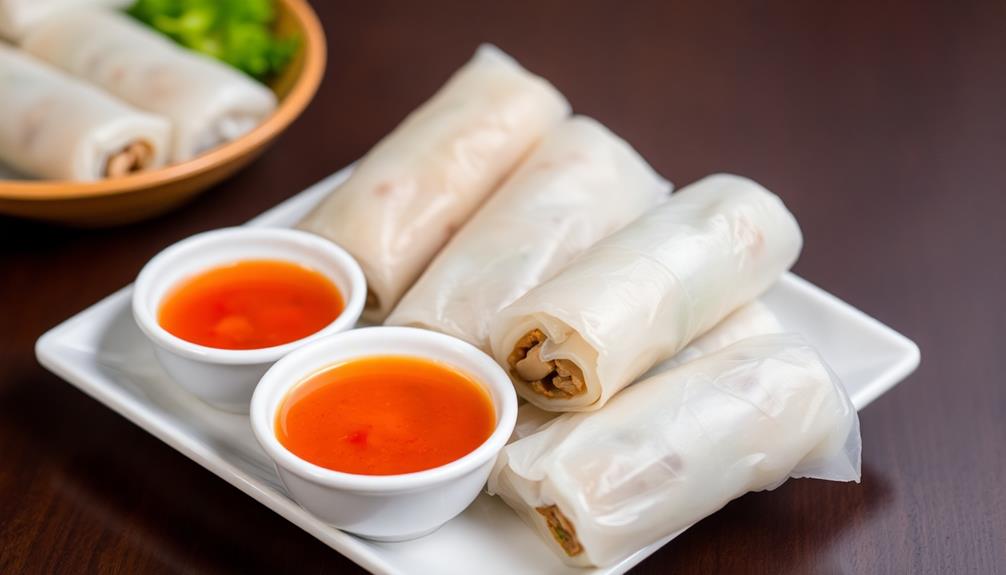
To complete the meal, serve the banh cuon with a delectable dipping sauce. This tasty sauce is the perfect accompaniment to the soft, tender rice rolls. Don't be shy – dip those rolls right in! The bright, tangy flavors will dance on your tongue and leave you craving more.
First, prepare the dipping sauce. In a small bowl, mix together fish sauce, lime juice, sugar, and a bit of water. Stir until the sugar dissolves completely. For an extra kick, add a sprinkle of chili flakes or finely chopped chilies.
Now, place the steaming hot banh cuon on a serving platter. Drizzle the vibrant dipping sauce over the top, or serve it on the side for everyone to enjoy.
The cool, slippery rolls paired with the zesty, umami-rich sauce is a match made in heaven. Go ahead, dip and savor every bite. This Vietnamese delight is sure to satisfy your cravings!
Final Thoughts
Having explored the rich history, cultural significance, and preparation of banh cuon, it's clear that this delicate Vietnamese delicacy is a true culinary delight.
Savoring these steamed rice rolls, you can almost feel the vibrant flavors and textures dance on your tongue. The soft, silky wrapper gives way to the flavorful filling, creating a harmonious symphony of tastes. Whether you prefer the classic pork and mushroom combination or venture into new territory with shrimp or vegetables, each bite is a delightful journey.
As you share this special dish with family and friends, you'll find that banh cuon isn't just a meal – it's a cultural experience. The act of wrapping, dipping, and savoring these rolls together fosters connections and creates shared memories.
Frequently Asked Questions
Can Banh Cuon Be Made in Advance?
Yes, you can make this dish in advance. The rice rolls can be prepared earlier and stored in the fridge. Just reheat them before serving to maintain their texture and flavor.
How Long Do Banh Cuon Last in the Fridge?
Freshly made banh cuon will last in the fridge for 3-4 days. Store them in an airtight container to maintain their texture and prevent drying out. Enjoy the leftovers within that timeframe for the best flavor and quality.
Can Banh Cuon Be Frozen and Reheated?
You can absolutely freeze and reheat banh cuon. Simply wrap them tightly in plastic or foil, then pop them in the freezer. When you're ready to enjoy, just thaw and reheat in the microwave or steamer.
What Are the Best Dipping Sauces for Banh Cuon?
The best dipping sauces for your dish are typically a mix of fish sauce, lime juice, chili, and sugar. You can also try a peanut or hoisin-based sauce to complement the delicate flavors of your steamed rolls.
Can Banh Cuon Be Made With Different Fillings?
Yes, you can make these rolls with a variety of fillings. While the traditional version uses minced pork and mushrooms, you can experiment with other ingredients like shrimp, chicken, or even vegetarian options like tofu or sautéed vegetables.
